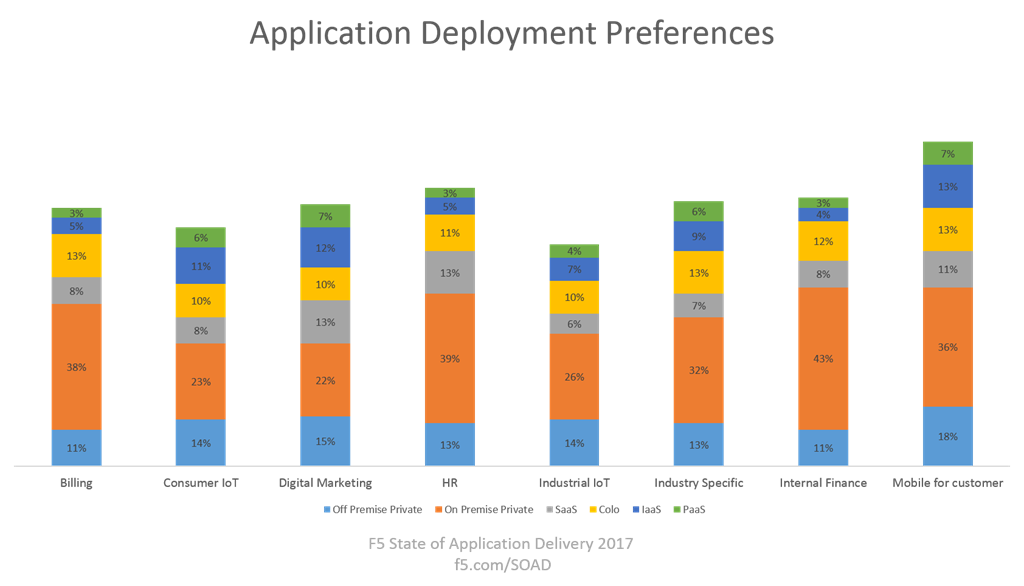Wenn eine App nicht in die Cloud kann, muss die Cloud in die App
Erkenntnisse aus dem State of Application Delivery 2017
Viele (und ich meine wirklich viele) Leute lehnen die bloße Existenz der Idee einer privaten (vor Ort vorhandenen) Cloud ab.
Das ist nichts Neues; ich kämpfe schon seit Jahren gegen das falsche Dilemma „die Öffentlichkeit ist der einzige Weg“. Es gab jedoch nie echte Daten darüber, ob das Phänomen der privaten Cloud tatsächlich existiert oder nur eine Einbildung der „Server-Huggers“, wie sie vor Jahren abwertend genannt wurden.

Doch dank unserer jüngsten Umfrage verfüge ich über echte Daten, die belegen, dass die private (lokale) Cloud nicht nur existenziell ist, sondern auch ihren attraktiveren Cloud-Cousins vorzuziehen ist. Zumindest vorerst.
Es war schon immer fraglich, ob bestimmte Arten von Anwendungen, insbesondere jene, die den Zugriff auf vertrauliche Unternehmensinformationen – etwa Finanzdaten – verwalten, größtenteils vor Ort gespeichert bleiben würden. Aber mobile Apps? Oh, die gehen in die öffentliche Cloud. In Massen. Es machen einfach alle, Liebling .
Aber das ist nicht der Fall. Oder zumindest nicht in den Massen, die die zahlreichen Blogs und Artikel zu diesem Thema suggerieren. Von den über 2.100 Teilnehmern unserer Umfrage entscheiden sich nur 17 % für die öffentliche (IaaS) Cloud für kundenorientierte mobile Apps. Weitere 7 % zielen auf PaaS und 11 % auf SaaS. Das bedeutet, dass insgesamt 35 % auf nicht-private Clouds abzielen. Der Großteil der Befragten (54 %) strebt eine private Cloud an, wobei jeder Dritte ausdrücklich eine private Cloud vor Ort bevorzugt.
Das Gleiche gilt für alle Anwendungskategorien. Ob Privat- oder Firmenkunden, Produktivitäts- oder Profitinteressenten, Geschäftszweige oder andere: Die Befragten zeigten eine starke Präferenz für die Private Cloud, wobei die lokale Bereitstellung klar der Favorit war.
Dies ist möglicherweise der Grund dafür, dass die Nutzung von OpenStack im Vergleich zum Vorjahr so stark zugenommen hat, da die Unternehmen ihre Pläne zur Implementierung einer privaten Cloud vor Ort vorantrieben. Letztes Jahr haben nur 7 % der Befragten OpenStack angenommen. Es gehörte zu den schwächsten der bekannten Frameworks und musste sich VMware, Cisco, Puppet und guten alten Python-Skripten geschlagen geben. Dieses Jahr? OpenStack gehört zu den führenden Frameworks, wenn es um die Nutzung geht. 21 % der Befragten gaben an, dass es in ihrer Organisation verwendet wird.
Nun, ich bin der öffentlichen Cloud nicht abgeneigt. Doch ich habe etwas gegen diejenigen, die gegenüber den Bitten der Unternehmen, deren sehr klare Forderungen weiterhin unerfüllt bleiben, weitgehend taub bleiben. Ich bin auch gegen Einheitslösungen, die die sich ändernden Anforderungen der Schwellenmärkte ignorieren.
Diese Märkte stellen fest, dass die Einfachheit und das Einheitsmodell der öffentlichen Cloud nicht für alle Größen geeignet ist. Das industrielle Internet der Dinge (IIoT) beispielsweise hat einige ziemlich komplexe Anforderungen, die von einer standardisierten (allgemeinen) öffentlichen Cloud-Umgebung nicht erfüllt werden können. Dies ist einer der treibenden Kräfte hinter GE Predix. IIoT benötigt die Skalierbarkeit und Agilität der Cloud, aber ebenso wichtig sind Sicherheit, Hörbarkeit und Leistung. Dan Woods stellte bei der Untersuchung des Themas Folgendes fest:
Die Zuverlässigkeit, Leistung und Sicherheit öffentlicher Clouds hat sich seit ihren holprigen Anfängen deutlich verbessert. Für industrielle Anwendungen reicht ihre Zuverlässigkeit jedoch noch immer nicht aus (siehe „ Warum GE vor einem größeren Problem steht als Amazon “).
Es ist daher keine Überraschung, dass sie sich anderen Optionen zuwenden.
Eine Option ist eine private Cloud vor Ort. Eine weitere Möglichkeit ist die schnell aufsteigende Colo-Cloud. Und das sehen wir in den Bereitstellungspräferenzen. IIoT konzentriert sich stark auf Umgebungen, die Unternehmen optimale Skalierbarkeit und Agilität bieten, ohne dabei Kontrolle und Leistung zu beeinträchtigen. Sogar das Consumer-IoT zeigt derzeit wenig Interesse an der öffentlichen Cloud.
In unserer jüngsten Umfrage stand die Private Cloud an der Spitze der Liste der Unternehmen mit der größten strategischen Wirkung (39 %) und ein erheblicher Prozentsatz (45 %, um genau zu sein) der Unternehmen investiert in den nächsten zwölf Monaten in die Private Cloud. Es wäre töricht, zu ignorieren, dass die Private Cloud kein vorübergehender Trend ist. Es handelt sich nicht um eine „Phase“, die launische Unternehmen durchlaufen. Es handelt sich um eine gezielte Geschäftsstrategie, die die digitale Transformation der Organisationen ermöglichen soll. Eine Transformation, die auch an Rechenzentren gebundene Apps umfassen muss .
Ja, die öffentliche Cloud ist auf dem Vormarsch. Das sehen wir auch. Die Veränderung des strategischen Einflusses der öffentlichen Cloud betrug im Vergleich zum Vorjahr 4 %. Das geänderte Interesse an der Bereitstellung von App-Diensten in der öffentlichen Cloud? Sie haben es erraten, im Durchschnitt 4 %. Zwar wird die öffentliche Cloud immer häufiger genutzt, aber es bleibt noch ein weiter Weg bis zum Wachstum.
Es gibt und wird noch viele, viele Jahre lang einen Markt für Rechenzentren geben. Solange Apps nicht länger an riesige Datenquellen gebunden sind oder durch die digitalen Kraken-artigen Tentakel der Integration gefangen gehalten werden, wird es einen Bedarf an privaten, lokalen Clouds geben, um die digitale Transformation zu ermöglichen, die Unternehmen durchlaufen müssen, um in einer digitalen Wirtschaft erfolgreich zu sein und zu wachsen.
